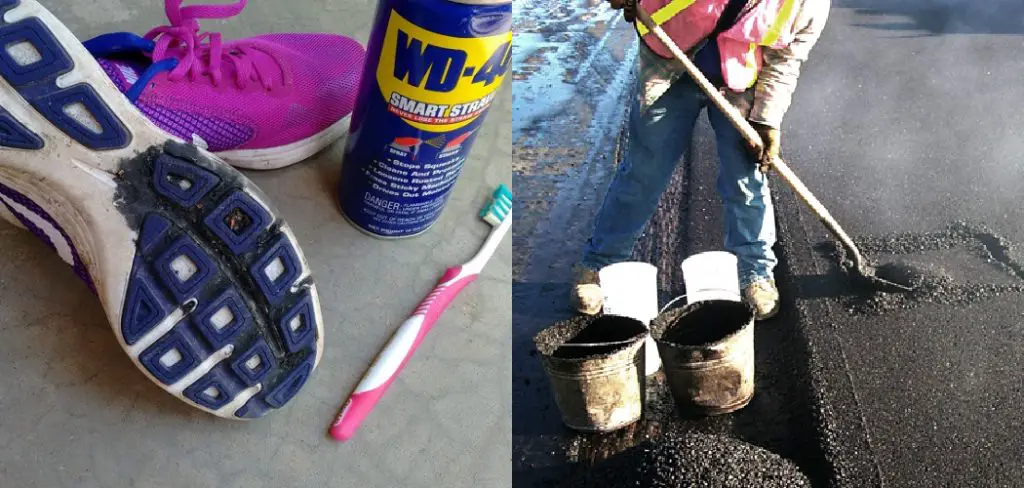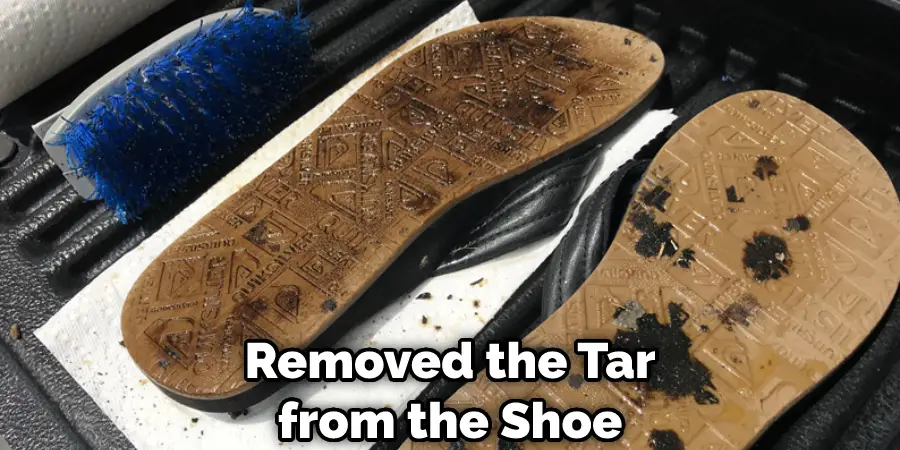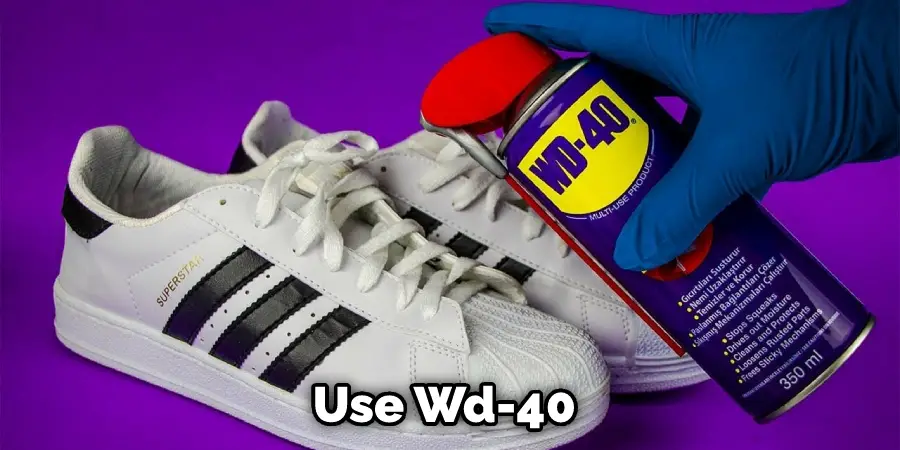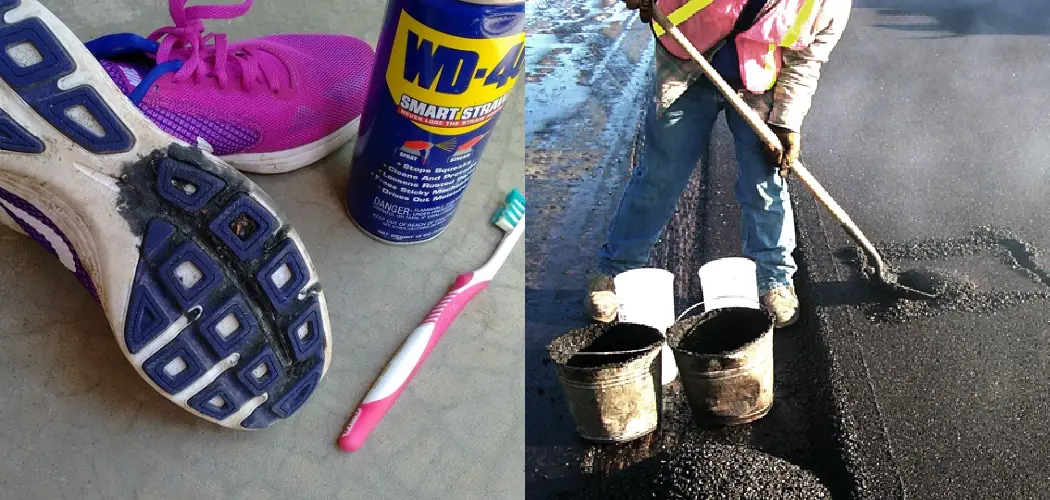If you’ve ever walked in a parking lot or on the street and your shoes got covered in black asphalt, you know how frustrating it can be to try to clean it off. Not only is the substance difficult to remove, but it can also stain your shoes pretty badly. This post will show you how to get asphalt off shoes quickly and easily. Read on for tips!

What is Asphalt?
Asphalt is a sticky, black, and highly viscous liquid or semi-solid that is often used for paving roads and parking lots. It is also a common ingredient in roofing tar. When asphalt gets on your shoes, it can be pretty tough to remove. However, there are a few methods that can help. Unfortunately, there are also a few things you should avoid doing, as they can make the problem worse.
What Causes Asphalt to Get on Shoes?
There are a few different ways that asphalt can end up on your shoes. One of the most common is by walking on an asphalt surface that has been freshly laid. The asphalt is still wet and can easily transfer to your shoes. Another way is by walking on an asphalt surface that is old and cracked. The cracks can trap small pieces of asphalt, which can then be transferred to your shoes.
Additionally, if you live in an area with a lot of construction, you may track asphalt into your home on your shoes. The other common way that asphalt can get on shoes is by wearing them in an area where there is a lot of road work or construction. This can happen if you live near a construction site or if you work in an industry that uses asphalt (such as roofing). Lastly, if you drive a car, you may get asphalt on your shoes from the soles of your shoes rubbing against the floor mat or carpet.
How to Get Asphalt Off Shoes in 4 Steps
Step 1. Preparing for Removal
The first step is to take off your shoes and any clothing that has asphalt on them. It’s important to do this as soon as possible, as the longer the asphalt sits on your clothing, the harder it will be to remove. Once you have removed your shoes and clothing, take them outside so that you can work on them away from any carpet or furniture.

Step 2. Removing a Thick Tar Piece/glob (Freezing Method)
If there is a thick piece of tar or a glob on your shoe, you can remove it by freezing it. First, fill a zip-top bag with ice cubes and place it over the tar. Let it sit for a few minutes until the tar hardens. Then, use a butter knife or a putty knife to scrape it off. If the tar is still sticky, you can place the shoe in the freezer for a few minutes to harden it further. If you don’t have a zip-top bag, you can use plastic wrap or wax paper. Avoid using metal, as it can damage your shoe.
Step 3. Removing Thin Smears or Spots (Oiling Method)
If the asphalt is in thin smears or spots, you can remove it by oiling it. This will dissolve the asphalt so that you can wipe it away. You will need:
– A can of mineral spirits or paint thinner
– A stiff brush
– A putty knife or trowel
First, pour some of the mineral spirits or paint thinner into a container. Then, dip the brush into the container and apply the solvent to the asphalt. Next, work the solvent into the asphalt with the brush. Next, use the putty knife or trowel to scrape away the dissolved asphalt. Finally, wipe away any residual solvent with a cloth. If necessary, you can repeat this process until all of the asphalt is removed.

Step 4. Cleaning with Detergent (If Necessary)
If there is still a residue left after removing the asphalt, you can try cleaning it with detergent. This may require some scrubbing, but it will eventually come off. First, mix equal parts water and detergent in a bucket. Next, use a sponge or brush to apply the mixture to the affected area. Finally, rinse the area with clean water. If you still have trouble removing the asphalt, you can try using a power washer. This will likely remove any remaining residue. Just be sure to hold the power washer at least a foot away from your shoes to avoid damaging them.
A 9 Step-by-step Process for How to Get Asphalt Off Shoes
Step 1. Scraping Off the Tar With a Plastic Knife
If there is a thick piece of tar or a glob on your shoe, you can remove it by freezing it. First, fill a zip-lock bag with ice and place it over the piece of tar. Let it sit for about 5 minutes so that the tar hardens. Once it is hard, you can use a plastic knife to scrape it off. You can repeat this process if there is still some tar left on the shoe.
You can also use a plastic knife to remove any excess tar on your shoe before beginning the freezing method. This will make it easier for the ice to freeze the remaining tar. It’s important to use a plastic knife, as metal can scratch your shoe and make the problem worse.
Step 2. Cleaning the Tar Stain Out of the Shoe
Once you have removed the tar from the shoe, you will need to clean the area where the tar was. You can do this by using mild soap and water. You will want to scrub the area where the tar was until the stain is gone. If you have a tough time getting the tar stain out, you may need to use a stronger cleaning product.

The best product for removing tar stains from shoes is WD-40. This can be found at most hardware or home improvement stores. Simply spray the WD-40 onto the affected area and let it sit for about 10 minutes. Then, scrub the area with a brush or cloth until the stain is gone.
Step 3. Use a Softener
If the tar has left your shoe feeling stiff, you can use a softener to help soften the material. There are many different types of softeners on the market, but you can also use something as simple as Vaseline. Apply a small amount of softener to the area of your shoe that is covered in tar. Allow the softener to sit for a few minutes before wiping it away with a cloth. If you don’t have a softener on hand, you can also try using olive oil. Apply a small amount of olive oil to the tar-covered area of your shoe and let it sit for a few minutes.
Then, wipe away the oil with a cloth. You can also use a hairdryer to heat up the affected area of your shoe. This will help soften the tar and make it easier to remove.
Step 4. Use a Solvent
You can try using a solvent if the tar is still not coming off your shoe. There are many different types of solvents on the market, so you may need to experiment with a few to find the one that works best. Apply the solvent to a clean cloth and rub it over the tar on your shoe. You may need to let the solvent sit on the tar for a few minutes before wiping it away. Be sure to read the instructions on the solvent before using it. Some solvents are flammable and should not be used near an open flame.
You can also try using rubbing alcohol or nail polish remover as a solvent. These products are often effective at breaking down tar and other sticky substances.
Step 5. Other Cleaning Options
If you still have trouble getting the tar off your shoe, you can try using WD-40 or nail polish remover. Apply a small amount of either substance to a clean cloth and rub it over the stained area. You may need to repeat this process a few times to get the tar to lift off completely. You can also try using a pumice stone to scrub the tar off your shoes. Be sure to test any cleaning method on a small, inconspicuous area of your shoe first to make sure it will not damage the material.

But be careful when using traditional cleaning products like bleach or harsh chemicals, as these can damage the material of your shoes. It’s always best to use gentle and natural methods for cleaning.
Step 6. Use Store-bought Products
If you are still having trouble getting the tar off your shoe, several store-bought products can help. There are many different brands of tar and asphalt removers, such as Multi-Use Product, Goo Gone, and Terminator. To use these products, follow the instructions on the label. Most products will require you to apply the remover to a cloth and then rub it onto the affected area. After a few minutes, the tar should start to lift off of the shoe. Once the tar is gone, be sure to wipe away any leftover residue with a clean cloth.
It’s always a good idea to test these products on a small area of your shoe first to make sure they will not damage the material.
Step 7. Vinegar Solution
Another household item that can help remove tar from shoes is vinegar. Create a solution of equal parts white vinegar and warm water in a bucket or container. Then, soak the affected area of your shoe in the solution for about 10 minutes. After soaking, use a brush or cloth to scrub away the tar. Rinse off the shoe with clean water, and repeat the process if necessary.
It’s important to note that vinegar may not be effective on all types of tar, so you may need to use another method if the stain persists.
Step 8. Baking Soda Paste
Baking soda is a natural cleaning agent and can also help remove tar from shoes. Create a paste by mixing baking soda with warm water. Apply the paste to the affected area of your shoe and let it sit for 10-15 minutes. Then, using a brush or cloth, scrub the paste into the tar stain until it starts to lift off. Rinse off the shoe with clean water and repeat the process if needed.
You can also try using a paste made of equal parts baking soda and coconut oil for an extra boost of cleaning power. It’s always a good idea to test the paste on a small area of your shoe first before applying it to the entire stain.
Step 9. Prevention is Key
While there are many methods for removing tar from shoes, prevention is always the best solution. When walking on roads or surfaces with tar, try to avoid stepping in it as much as possible. If you do happen to get tar on your shoes, immediately wipe it off with a paper towel or cloth before it has a chance to harden and stick.
Additionally, regularly cleaning and maintaining your shoes can help prevent the build-up of sticky substances like tar. Wipe down your shoes after each use and give them a deeper clean every few weeks. This will not only prevent stains but also prolong the life of your shoes.
By following these steps and using the appropriate cleaning methods, you can easily remove tar from your shoes and keep them looking as good as new. Remember to always be gentle with the material of your shoes and test any cleaning method on a small area first. With a little bit of effort, your shoes will be free of tar and ready to hit the streets again. Happy cleaning!
Tips and Warnings on How to Get Asphalt Off Shoes:
Tips:
- Rinse the shoes with cold water as soon as possible.
- Scrape off any excess asphalt with a blunt knife.
- Create a paste with baking soda and water and apply it to the asphalt-stained areas of the shoes.
- Let the paste sit for 15 minutes, then scrub it off with an old toothbrush.
- Repeat steps 3 and 4 if necessary.
- Rinse the shoes with cold water and let them air dry.
- Take preventative measures in the future, such as avoiding walking on freshly laid asphalt or wearing protective shoe covers.
Warnings:
- Do not use hot water on asphalt-stained shoes, as this will set the stain.
- Do not put asphalt-stained shoes in the washing machine, as this will damage the machine.
- Do not wear asphalt-stained shoes until they have been cleaned, as the stain will spread.
- Use caution when using solvents or other chemicals on your shoes, as they may cause damage to the material.
- Always test a cleaning method on a small, inconspicuous area of your shoe first before applying it to the stained area.
- Keep these products out of reach of children and pets.
- If you experience any skin irritation while using a cleaning product, stop immediately and rinse the affected area with water.
- If you are unsure about how to safely clean your shoes, seek professional help or consult the manufacturer’s instructions.
Frequently Asked Questions:
Q1: Can I Use Traditional Cleaning Products Like Bleach to Remove Asphalt From My Shoes?
A1: It’s not recommended to use harsh chemicals or bleaches on your shoes as they can damage the material. It’s best to use gentle and natural methods for cleaning. You can also try store-bought tar and asphalt removers or household items like vinegar and baking soda. It’s always a good idea to test these products on a small area first before applying them to the entire stain.
Q2: How Do I Prevent Asphalt From Sticking To My Shoes?
A2: Prevention is key when it comes to asphalt stains. Try to avoid walking on freshly laid asphalt or wear protective shoe covers if you know you will be in an area with a lot of asphalt. Regularly clean and maintain your shoes to prevent the build-up of sticky substances. If you do get asphalt on your shoes, immediately wipe it off with a paper towel or cloth before it hardens and becomes more difficult to remove.
Q3: Can I Use a Pressure Washer to Remove Asphalt From My Shoes?
A3: It’s not recommended to use a pressure washer on your shoes as it can damage the material and spread the stain further. Stick to gentler cleaning methods like those mentioned in this guide. You can also seek professional help or consult the manufacturer’s instructions for specific cleaning recommendations for your shoes.
Conclusion
So there you have a few simple steps on How to Get Asphalt Off Shoes. Follow these steps, and your shoes will look good as new in no time. Read the tips and warnings before starting, as some methods may damage your shoes if not used correctly. Remember, it’s always best to act quickly when dealing with asphalt stains, so try to clean your shoes as soon as possible after getting them dirty. With a little bit of effort and the right cleaning methods, you can easily remove asphalt from your shoes and keep them looking fresh for longer. Thanks for reading, and good luck!

